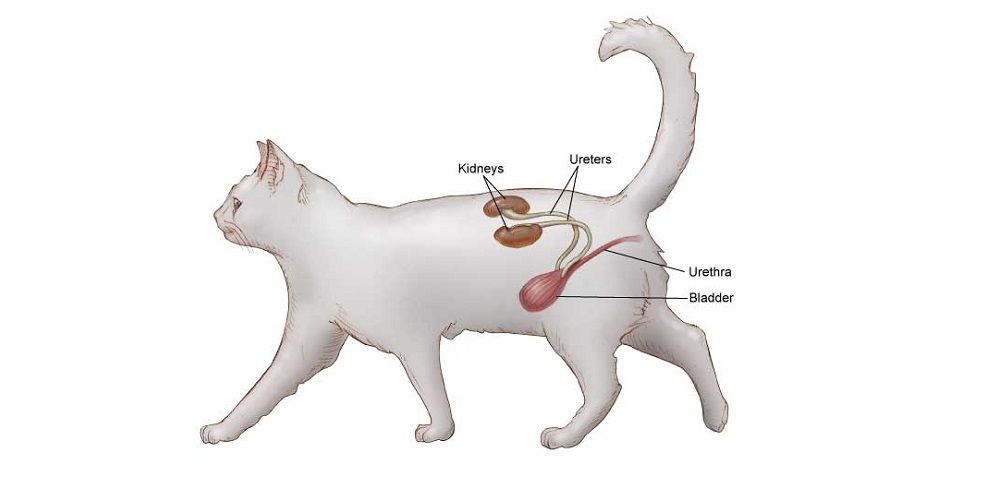Acute Renal Failure in Dogs and Cats
By Jessica Romine, DVM, DACVIM, Board-Certified in Small Animal Internal Medicine, BluePearl Specialty and Emergency Pet Hospital in Southfield, Michigan
The kidneys perform critical functions for dogs and cats, including filtering blood, eliminating waste in urine, and maintaining proper hydration, electrolyte balance, bone strength, blood pressure and red blood cell production. All of these functions are vital for dogs and cats to live optimally, and because of this, the kidneys have a high need for blood flow (20% of blood flow despite only making up 0.5% of the body weight) and high metabolic demand, making them particularly prone to toxic or low-oxygen injury.
Despite advances in the treatment of acute renal failure, it remains a serious and often fatal disease. Acute kidney injury develops in 15-22% of hospitalized dogs and cats, and even minor renal injury increases mortality in people and animals. About 60% of dogs and cats with this disease either die or are humanely euthanized because of failure to respond to supportive care.
Causes
When kidneys suddenly fail, various toxins in the body can no longer be excreted. Rapid onset of kidney dysfunction can be caused from accidental ingestion of poisonous foods, plants, and medications such as antifreeze (radiator fluid, ethylene glycol), lily plants (only cats), raisins and grapes, and pain pills like aspirin or ibuprofen (Advil® or Motrin®).
While kidney infections can happen spontaneously, there is often a preexisting illness or condition that decreases a dog or cat’s ability to fight infection. Examples of such are kidney stones, partial urine blockage or chronic kidney disease, which usually stems from congenital defects, immune system diseases or buildup of toxins.
One bacterial infection that can cause acute kidney failure in dogs, but rarely in cats, is Leptospirosis (Leptospira spp.). Dogs can contract leptospirosis from urine or water contaminated by infected animals, such as deer, cattle, rats, raccoons, mice or other dogs.
Dehydration, heatstroke or other disorders causing massive damage to body tissues, such as bee stings or snakebites, can also lead to kidney failure. In addition, prolonged low blood pressure will damage kidney function.
Signs
Symptoms of kidney failure include excessive thirst, lethargy, poor or absent appetite, or vomiting. In severe kidney failure, the amount of urine may decrease or the pet may stop making urine altogether. Stomach or intestinal ulcers may also develop, which can result in either a black or tarry stool or vomiting of digested blood. Most often, gastrointestinal signs are the most obvious and are what prompt a visit to the vet.
Diagnosis
AKI is officially defined as a creatinine increasing above the normal range (without the presence of chronic kidney disease). Since creatinine doesn’t rise until kidney blood flow has been significantly affected, even rising creatinine while still within the reference range is indicative of renal damage, particularly if occurring in the face of supportive care therapies such as IV fluids.
The diagnosis of acute kidney injury requires bloodwork, oftentimes repeatedly to trend changes in BUN (urea), creatinine, electrolytes, acid-base status, and other markers of kidney function. X-rays, ultrasound, and urine testing and culture are often used as well. Sometimes a biopsy of the kidney is recommended, and the actual cause is not always apparent, if there is not a known toxin exposure, low blood pressure event, or infection present.
Treatment
Initial treatment for acute kidney failure is intravenous (IV) fluids. These fluids restore hydration and flush out substances that normal functioning kidneys remove from the bloodstream. Since a decrease in urine can indicate the need for other therapies, urine production is monitored throughout the IV fluid therapy.
A urinary catheter may also be used to measure urine volume. If urine production is less than IV fluid input, this could indicate fluid retention. Fluid retention in dogs and cats manifests itself as increased body weight, belly bloating, swollen legs, or shortness of breath (if fluid builds up in the lungs).
If the cause of the kidney failure is suspected to be infection, antibiotics will also be given. Additionally, pets with kidney failure often refuse to eat, so anti-nausea and acid-suppressant therapies may be used, as well as appetite stimulants. If the dog or cat continues to be reluctant to eat, a temporary feeding tube may be placed to ensure that proper nutrition is being met.
With acute kidney failure, potassium levels—an electrolyte normally found in the blood in controlled levels—may also increase to dangerous levels. High potassium levels can slow the heartbeat and even cause the heart to stop, so this needs to be trended closely. Conversely, very high blood pressure could also develop, so blood pressure medication may be needed.
Advanced Therapies
If the pet does not respond to IV fluids, advanced therapies such as peritoneal dialysis or hemodialysis are recommended. Signs that indicate these therapies should be considered include:
- Dangerously high potassium level
- Fluid in the lungs
- Decreasing urine output
- Lack of improvement in blood values while a patient receives IV fluids
Peritoneal Dialysis
Peritoneal dialysis involves placing a tube directly into the abdominal cavity, infusing fluid in to absorb toxins like BUN, creatinine, and potassium, and then draining the fluid back out to prevent them from being taken back up into the bloodstream. This flushes out toxins that the kidneys fail to remove. The procedure requires strict doctor or nurse supervision to keep the fluid moving in and out.
Hemodialysis
With Hemodialysis, doctors place a specialized IV catheter in the pet’s vein. This catheter will remove a specific amount of blood, which is then sent through a machine (centrifuge) that cleanses the blood. Hemodialysis is effective, but only a handful of veterinary hospitals are equipped with the tools and technologies to perform the procedure, and it requires very intensive monitoring.
It is important to note that both peritoneal dialysis and hemodialysis are expensive treatment options. These therapies are usually reserved for patients in whom medical treatment has failed, and for whom the odds of survival without dialysis are close to 0%.
Even in patients that recover from acute kidney failure, the recovery may be incomplete, leaving the patient with chronic kidney disease that will require life-long ongoing care. However, many animals do recover fully and lead normal lives!
For more information on acute kidney failure or chronic kidney disease, speak with your veterinarian.



